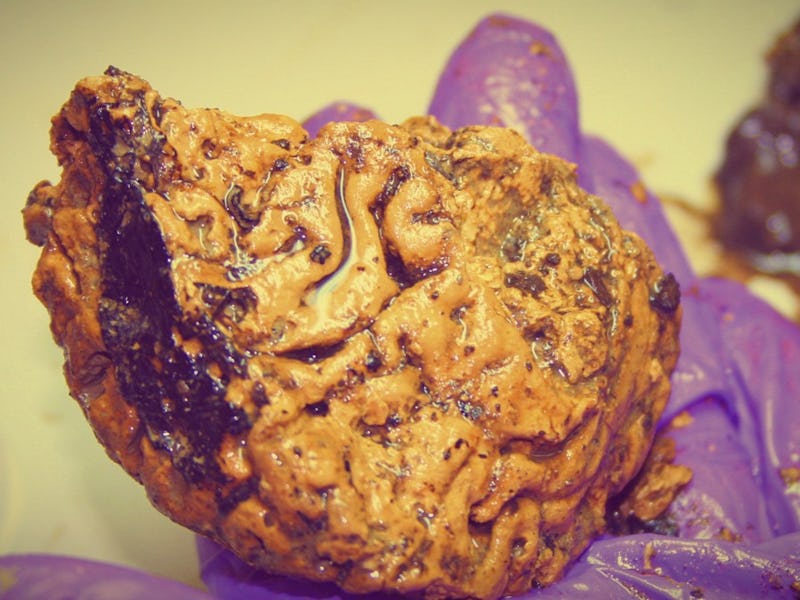Scientists discover beheaded man's brain self-preserved for 2,600 years
The ancient brain avoided the body's self-destruct process.

Around 2,600 years ago, about the time humans started making steel and building weapons, a man lost his head. Subsequently, the real-life, Iron Age Ned Stark’s lopped-off skull became buried in clay-rich mud, and remained there until York Archeological Trust researchers dug it up in 2008. They made the finding in Heslington, a suburban village near modern-day York, England.
What they found inside the ancient man’s skull shocked them: A large chunk of the brain was in remarkable shape, considering its age. The brain tissue, now known as the “Heslington brain”, had shrunk slightly over the years, but still contained its hallmark grooves and folds.
It’s considered the oldest preserved brain ever found in Eurasia, and is likely the best-preserved ancient brain overall. In a study released this week in the Journal of the Royal Society Interface researchers reveal why it’s been able to stand the test of time.
The Heslington Brain.
For the past decade, scientists have sought to understand how and why the Heslington brain could have survived. In the study, the researchers note that, apart from this brain, no other brain from the Iron Age has been found preserved without deliberate human intervention.
That’s because the human brain breaks down rapidly after death. When a person dies a process called autolysis kickstarts, which causes tissues and organs to break down. The brain is 80 percent water and one of the first organs to go down. Within five to 10 years, the brain tissue is typically totally degraded, research suggests.
So the Heslington brain’s zombie-like condition was perplexing to scientists, when most human brains don’t survive decades, let alone millennia in the ground, except under specific conditions like deliberate mummification or in ice.
The Heslington Brain, discovered during an archeological dig by York Archeological Trust.
However, through a complicated series of molecular and statistical analyses, the researchers discovered what made the Heslington brain endure: protein clumping.
That means that the brain actually preserved itself. When researchers took a closer look, they discovered that certain proteins, which support the structure of nerve and brain cells like neurons and astrocytes, were clustered close together in the brain tissue. The protein aggregation kept the brain tissue stable over time, helping slow down the natural decomposition process.
Surprisingly, the researchers also found that the Heslington neural proteins were more stable than modern-day brains. Protein stability is an indirect signal of how well a protein is functioning, the researchers explain.
Interestingly, protein aggregation typically comes along with brain diseases like Alzheimer’s and Parkinson’s, although the researchers didn’t find evidence of these conditions in the ancient brain.
In this case, scientists aren’t sure what sparked this critical clumping process, but speculate that it may relate to where and how the skull was buried.
The team’s findings have the potential to spark novel preservation techniques for the human brain — in life and after death. Quite the legacy for an ancient human.
Abstract:
Human proteins have not been reported to survive in free nature, at ambient temperature, for long periods. Particularly, the human brain rapidly dissolves after death due to auto-proteolysis and putrefaction. The here presented discovery of 2600-year-old brain proteins from a radiocarbon dated human brain provides new evidence for extraordinary long-term stability of non-amyloid protein aggregates. Immunoelectron microscopy confirmed the preservation of neurocytoarchitecture in the ancient brain, which appeared shrunken and compact compared to a modern brain. Resol- ution of intermediate filaments (IFs) from protein aggregates took 2–12 months. Immunoassays on micro-dissected brain tissue homogenates revealed the preservation of the known protein topography for grey and white matter for type III (glial fibrillary acidic protein, GFAP) and IV (neu- rofilaments, Nfs) IFs. Mass spectrometry data could be matched to a number of peptide sequences, notably for GFAP and Nfs. Preserved immunogenicity of the prehistoric human brain proteins was demonstrated by antibody gen- eration (GFAP, Nfs, myelin basic protein). Unlike brain proteins, DNA was of poor quality preventing reliable sequencing. These long-term data from a unique ancient human brain demonstrate that aggregate formation permits for the preservation of brain proteins for millennia.